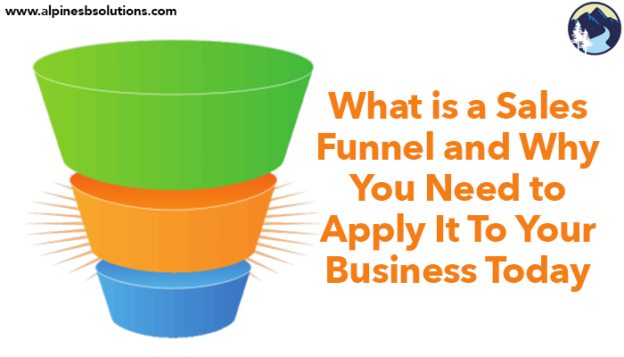For businesses, sales are the foundation on which everything is based. Without a product or service to sell, your organization wouldn’t exist! An effective sales strategy is crucial to the survival (and hopefully thriving) of your organization, and guess what; a great tool to help is a sales funnel.
The Idea Behind the Sales Funnel
 A sales funnel is an analogy used to explain how the sales process works. It serves as a visual representation of how an individual moves from knowing nothing about your organization to becoming a loyal customer and hopefully brand evangelist for you. The mindset of a sales funnel views sales as a proactive process of making customers (as opposed to the more passive process of finding customers). The underlying goal of the sales funnel is to convert those who are unaware of your organization to happy customers by finding as many quality leads as possible and getting the percentage of people who go through the funnel as high as possible.
A sales funnel is an analogy used to explain how the sales process works. It serves as a visual representation of how an individual moves from knowing nothing about your organization to becoming a loyal customer and hopefully brand evangelist for you. The mindset of a sales funnel views sales as a proactive process of making customers (as opposed to the more passive process of finding customers). The underlying goal of the sales funnel is to convert those who are unaware of your organization to happy customers by finding as many quality leads as possible and getting the percentage of people who go through the funnel as high as possible.
The Stages of the Sales Funnel
Many different takes on the sales funnel exist, but this is the simplest and (I think) most effective way of viewing it.
- The lead: The sales funnel begins with individuals who are in your target audience. They may be interested in what you offer, but have no contact yet with your organization and are unaware of what your organization offers. This part of the funnel is the largest, so it’s important to utilize a variety of effective lead-gathering strategies. You just have to show them how you can solve a problem for them…maybe one they didn’t even know they had!
- The prospect: At this stage, you’ve made contact with the individuals. They are aware of your organization and how you can meet their needs. They’ve expressed some interest in your organization that merits you pursuing these potential customers. Often times, prospects are simultaneously evaluating their other options, so it’s important to clearly showcase what sets your organization apart from your competitors.
- The committed: After all your hard work and negotiations, these individuals are now persuaded. They possess the means and desire to purchase your product/service, and all that’s left is working out the logistical details, such as a contract. Individuals at this stage can still back out though, so proactive effort into quality customer service is needed to prevent them leaving.
- The customer: Finally! These individuals happily buy your product/service and
 become a customer. In situations where contracts need to be renewed or purchases made again, the customer will enter a re-evaluation phase. In some respects, they become a prospect again since they can now evaluate their other options. Effective customer service will minimize the amount of time and effort they spend weighing alternatives, and ideally they will be such a satisfied customer that they renew the contract or buy more of your product right away. Remember, it is much easier to have a repeat customer than generate a whole new lead. Keep those customers happy. If you have a good customer base, they will become your cheerleaders. You know what that means…FREE MARKETING!
become a customer. In situations where contracts need to be renewed or purchases made again, the customer will enter a re-evaluation phase. In some respects, they become a prospect again since they can now evaluate their other options. Effective customer service will minimize the amount of time and effort they spend weighing alternatives, and ideally they will be such a satisfied customer that they renew the contract or buy more of your product right away. Remember, it is much easier to have a repeat customer than generate a whole new lead. Keep those customers happy. If you have a good customer base, they will become your cheerleaders. You know what that means…FREE MARKETING!
Reasons to Utilize the Sales Funnel
- It’s an effective measurement tool. Sales funnels allow you to measure the
 number of individuals at each stage, the percent of customers made from leads, and the average time it takes to move a customer down the funnel. Gathering these metrics provides you with a more holistic method of comparison to gauge successful sales efforts than just sales completed. After enough time using the sales funnel, you’ll be able to see a baseline of what you can expect from your sales team. Deviations from this baseline will show you what works well or what needs to be improved in your sales strategy.
number of individuals at each stage, the percent of customers made from leads, and the average time it takes to move a customer down the funnel. Gathering these metrics provides you with a more holistic method of comparison to gauge successful sales efforts than just sales completed. After enough time using the sales funnel, you’ll be able to see a baseline of what you can expect from your sales team. Deviations from this baseline will show you what works well or what needs to be improved in your sales strategy. - It’s a tool to measure the company’s health. A well-flowing sales funnel (accounting for external influences like the economy or the off-season of selling, of course) reflects an effective sales team and strategy. A sales funnel functioning well shows your company is doing well. A sales funnel functioning poorly can be an indicator that changes need to be made to improve the health of the organization.
- It showcases what areas need to be targeted to get adequate numbers. Ideally,
 the numbers will always be high at every phase. The reality, however, is that the numbers fluctuate often. Using a sales funnel highlights areas that should be targeted to get the numbers to where they need to be for effective customer recruitment. If you see you’re lacking leads, you can put more resources into lead generation. If you see you have enough leads but not enough are becoming prospects or committed, you can put more resources into bettering your pitch. If you see enough customers aren’t returning when contracts need to be renewed, you can put more resources into customer service.
the numbers will always be high at every phase. The reality, however, is that the numbers fluctuate often. Using a sales funnel highlights areas that should be targeted to get the numbers to where they need to be for effective customer recruitment. If you see you’re lacking leads, you can put more resources into lead generation. If you see you have enough leads but not enough are becoming prospects or committed, you can put more resources into bettering your pitch. If you see enough customers aren’t returning when contracts need to be renewed, you can put more resources into customer service.
A sales funnel is a great way to improve the effectiveness of your organization’s sales strategy as well as improve your system. Want help in implementing the sales funnel into your sales strategy? Alpine Small Business Solutions is here for you! We would love to help with this (or any aspect of business building). Simply email or call us today.


